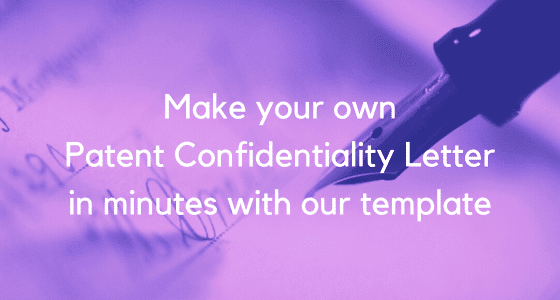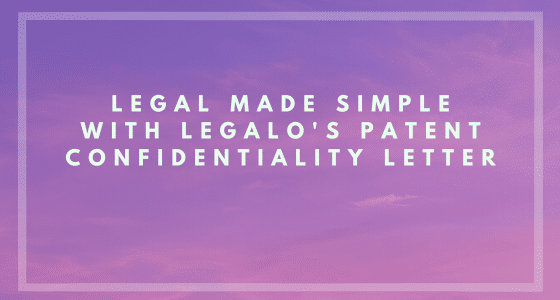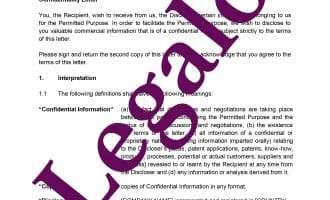Patent Confidentiality Letter
Our Patent Confidentiality Letter Template:
- Simple to complete
- In plain English
- Drafted by an expert UK lawyer
- Money-back guarantee

How Does It Work?
-
1. Download
-
2. Edit
-
3. Print
-
4. Sign
Do you feel like you have designed or invented the next big thing? If you do and you plan on getting a patent for your design, idea, or invention, you should definitely have everyone involved with the project sign the patent confidentiality letter. You wouldn’t want to risk making your patent application void if you disclosed something prematurely in an insecure manner. The exception to this rule is your professional advisers, such as solicitors. Solicitors are already under a duty of confidentiality to their clients.
Why you need a Patent Confidentiality Letter
If you or an associate leaked or disclosed your idea or invention accidentally or without your permission, you could lose the validity of the patent application. The patent confidentiality letter that we have on our website was drafted by a UK lawyer. It is in clear terms that are easy to understand and use. You can buy with confidence, knowing that the template is cost-effective and legally binding.
You need to have it protected when you are trying to:
- get help from a third party, such as an investor, or
- just garner some interest in your idea, invention, prototype or new product.
Ideas are not protected by copyright. Before you can get a patent on it, you don’t want someone to:
- disclose any of this information, or
- to steal your idea.
By having anyone that you may deem necessary to the project sign the patent confidentiality letter, you will not only protect the idea but you will be protecting the entire patent process.
We have a full range of confidentiality agreements – click on this link to see them.

Using our Patent Confidentiality Letter template
Our patent confidentiality letter has been designed so that everything remains safe during the patent application process. If you need to be specific in the patent confidentiality letter, then it can easily be customised to fit your exact needs. Because you are able to download this template, you can use it again and again and change it to your needs as often as you like. We have drafted the document so that everything you need is in it. Therefore you won’t have to do much customising, making our template even easier for you to use.
Guide to our Patent Confidentiality Letter Template
Our Patent Confidentiality Letter template is for use by a party who has agreed with a second party to release sensitive or confidential information to the second party about:
- an actual registered patent;
- a patent application that has been filed but is still pending; or
- an idea that might later be the subject of a patent application.
Good examples are working with someone to:
- develop a prototype of an invention,
- refine a prototype, or
- help with the design work or tooling.
The owner of the information is sharing it only on condition that the recipient does not steal or misuse it, or disclose to others.
You often need confidentiality provisions, such as those in this template, to protect ideas and other sensitive commercial information. Copyright laws may extend a basic protection to some data and other information, but the ideas or concepts behind information need to be protected by as ideas or concepts themselves are not protected by copyright. You should not disclose such information verbally or in writing until you have a signed confidentiality letter in place. Information about patents might be particularly valuable and is unprotected until a patent application has been granted.
Inventors should be very wary about sharing their ideas until the IPO has granted a patent. Even after the grant of the patent, there may be a need for a confidentiality agreement of some sort relating to other secret information or in case the definition of the patent was not worded very well.

Clauses in this Patent Confidentiality Letter
1. Interpretation
This clause defines the main terms used in the patent confidentiality letter.
- Confidential Information – This states what constitutes confidential information. Amend the words in square brackets if need be, so that they refer to the types of information that you might disclose under this letter.
- Copies – This ensures that the letter also protects any Confidential Information on computer media, etc, and not just hard copies.
- Discloser – Here fill in the details of the party sending the letter. If they are a person and not a company, use the following format: “[NAME] of [ADDRESS]”.
- Permitted Purpose – Complete the details of what the purpose is of the recipient’s receiving this information – see our suggested words in square brackets in this definition. If the information relates to a registered patent, then delete the words “potential OR pending”. If it relates to a pending patent application that you have filed but the IPO has not yet granted, then delete the words “potential OR”. If you have not yet filed an application, then delete the words “OR pending”.
- Recipient – Here fill in the details of the recipient party. If they are a person and not a company, use the following format: “[NAME] of [ADDRESS]”.
2. Purpose and use of disclosed information
Clause 2.2 provides that the recipient is only to use the confidential information for the permitted purpose. Clause 2.3 provides that any information the owner discloses prior to the date of the letter is also under its protection. Please note however that this is not ideal. It may not work if you did not state verbally that the recipient was to keep the information confidential at the time you disclosed it. So you should only disclose sensitive information after both parties have signed such an letter. Clause 2.4 extends the protection to any copies the recipient makes as part of the permitted purpose. It also states that the discloser can require the recipient to return the originals and return, destroy or erase all copies.
3. Obligations
In addition to clauses 2.2 and 5 in the patent confidentiality letter, this clause sets out the rules for the protection of the confidential information – what the recipient can and cannot do.
4. Exceptions
This clause acknowledges that if the information has lost its characteristic of being confidential, the protection of the letter no longer applies to it. It is therefore important that the discloser is careful to maintain the secrecy of its information. These exceptions are standard provisions.
5. Permitted third party disclosure
This clause restricts the recipient passing on the information, even to members of staff. Choose which of the 2 options in clause 5.1.1 you prefer – the first is the more restrictive.
6. Copies
This clause means that you limit copying the information, the recipient is to protect the copies and the discloser also owns the copies.
7. Forced disclosure
In exceptional cases a court or other governmental authority having special powers might order disclosure of the information by the recipient. The recipient will have to comply if this is the case, but clause 7.2 sets some steps that the recipient must first taken to demonstrate this is the case.
8. Term and termination
Even though either party may terminate the terms of this patent confidentiality letter on notice, the confidentiality provisions will survive and remain in place without a time limit.


